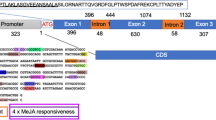Abstract
Brassinosteroids have been reported to accelerate plant growth when applied to seeds. We examined the effects of seed treatment with brassinolide on early growth of Lepidium sativum (cress). Submicromolar and micromolar concentrations of brassinolide inhibited root growth within 48 h after seed treatment. Germination of cress was not affected by brassinolide. The inhibition of cress root growth by brassinolide was time specific in terms of eliciting the response. Untreated germinated seeds transferred to filter paper moistened with brassinolide solution did not exhibit the same level of root inhibition as treated seeds. Brassinolide (2 μm) had no effect on ethylene levels, suggesting that at this concentration brassinolide is acting independently of ethylene to inhibit cress root elongation. Also, brassinolide had no effect on DNA synthesis within 24 h after seed treatment, but synthesis was reduced after 48 h. The results of this study illustrate a significant specific effect on very early cress root growth by seed treatment with brassinolide.
Similar content being viewed by others
Abbreviations
- BR:
-
brassinosteroid(s)
- SDS:
-
sodium dodecyl sulfate
- TCA:
-
trichloroacetic acid
- ACC:
-
1-aminocyclopropane-1-carboxylic acid
References
Arteca RN, Bachman JM, Yopp JH, Mandava NB (1985) Relationship of steroidal structure to ethylene production by etiolated mung bean segments. Physiol Plant 64:13–16
Clouse SD, Hall AF, Langford M, McMorris TC, Baker ME (1993) Physiological and molecular effects of brassinosteroids on Arabidopsis thaliana. J Plant Growth Regul 12:61–66
Gregory LE (1981) Acceleration of plant growth through seed treatment with brassins. Am J Bot 68:586–588
Heisey RM (1990a) Allelopathic and herbicidal effects of extracts from tree of heaven (Ailanthus altissima). Am J Bot 77:662–670
Heisey RM (1990b) Evidence for alleopathy by tree-of-heaven (Ailanthus altissima). J Chem Ecol 16:2039–2055
Lehle FR, Putnam AR (1982) Quantification of allelopathic potential of sorghum residues by novel indexing of Richards' function fitted to cumulative cress seed germination curves. Plant Physiol 69:1212–1216
Mandava NB (1988) Plant growth-promoting brassinosteroids. Annu Rev Plant Physiol Plant Mol Biol 39:23–52
Mandava NB, Sasse JM, Yopp JH (1981) Brassinolide, a growth-promoting steroidal lactone. II. Activity in selected gibberellin and cytokinin bioassays. Physiol Plant 53:453–461
Robert ML, Taylor HF, Wain RL (1975) Ethylene production by cress roots and excised cress root segments and its inhibition by 3,5-diiodo-4-hydroxybenzoic acid. Planta 126:273–284
Roddick JG (1994) Comparative root growth inhibitory activity of four brassinosteroids. Phytochemistry 37:1277–1281
Roddick JG, Ikekawa N (1992) Modification of root and shoot development in monocotyledon and dicotyledon seedlings by 24-epibrassinolide. J Plant Physiol 140:70–74
Roddick JG, Rijenberg AL, Ikekawa N (1993) Developmental effects of 24-epibrassinolide in excised roots of tomato grown in vitro. Physiol Plant 87:453–458
Sambrook J, Fritsch EF, Maniatis T (1989) Molecular cloning: A laboratory manual, 2nd ed. Cold Spring Harbor Laboratory, Cold Spring Harbor, NY, pp E.18-E.19
Sasse JM(1991) Brassinosteroids: Are they endogenous plant hormones? PGRSA Q 19:1–18
Schlagnhaufer C, Arteca RN (1985) Brassinosteroid-induced epinasty in tomato plants. Plant Physiol 78:300–303
Takeuchi Y, Worsham AD, Awad AE (1991) Effects of brassinolide on conditioning and germination of witchweed (Striga asiatica) seeds. In: Cutler HG, Yokota T, Adam G (eds) Brassinosteroids: Chemistry, bioactivity and applications. ACS symposium series 474, Washington, D.C., pp 298–305
Yamaguchi T, Wakizuka T, Hirai K, Fujii S, Fujita A (1987) Stimulation of germination in aged rice seeds by pretreatment with brassinolide. Proc Plant Growth Regul Soc Am 14:26–27
Yopp JH, Mandava NB, Sasse JM (1981) Brassinolide, a growth-promoting steroidal lactone. I. Activity in selected auxin bioassays. Physiol Plant 53:445–452
Author information
Authors and Affiliations
Rights and permissions
About this article
Cite this article
Jones-Held, S., VanDoren, M. & Lockwood, T. Brassinolide application to Lepidium sativum seeds and the effects on seedling growth. J Plant Growth Regul 15, 63–67 (1996). https://doi.org/10.1007/BF00192933
Received:
Accepted:
Issue Date:
DOI: https://doi.org/10.1007/BF00192933




